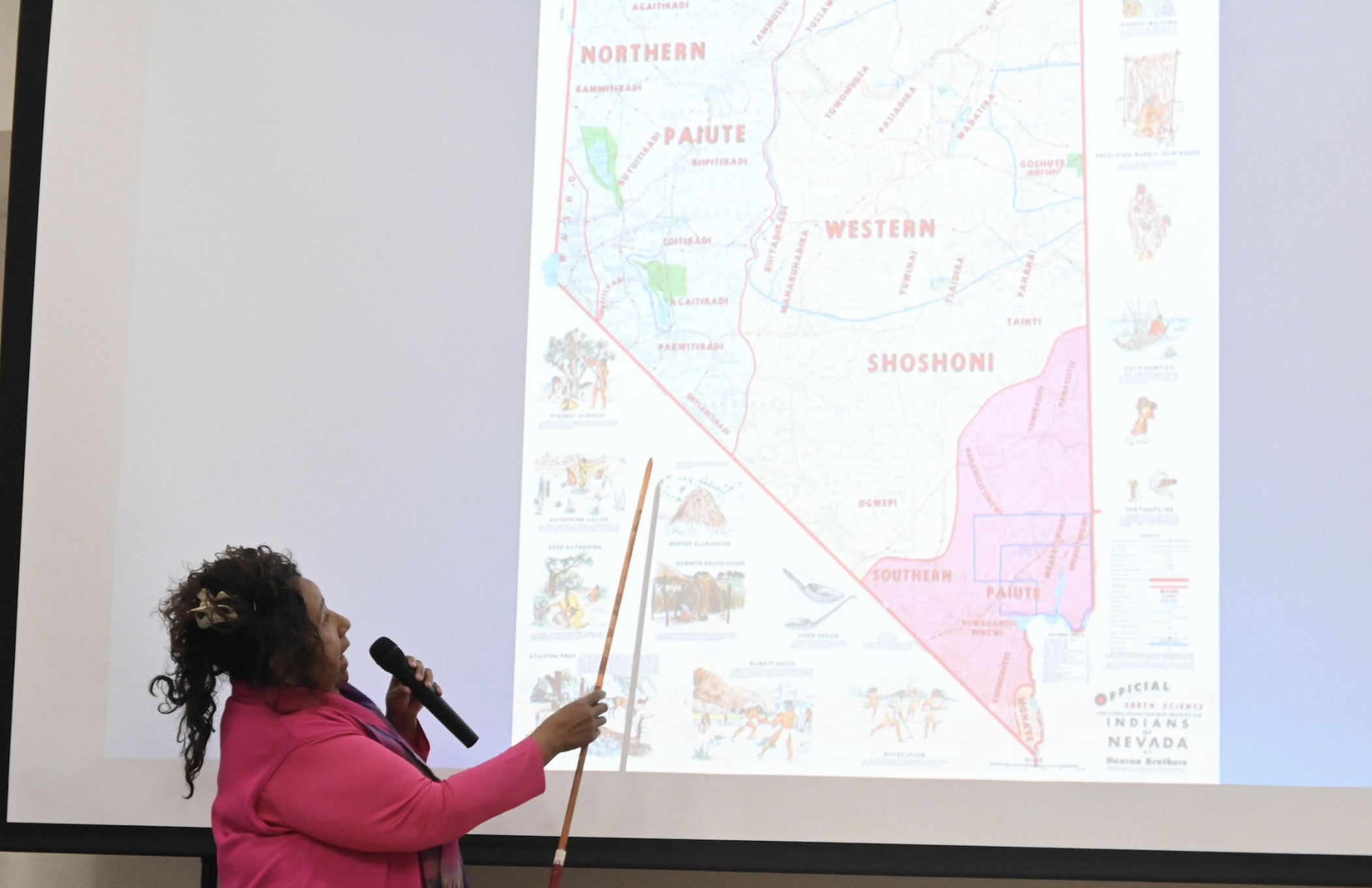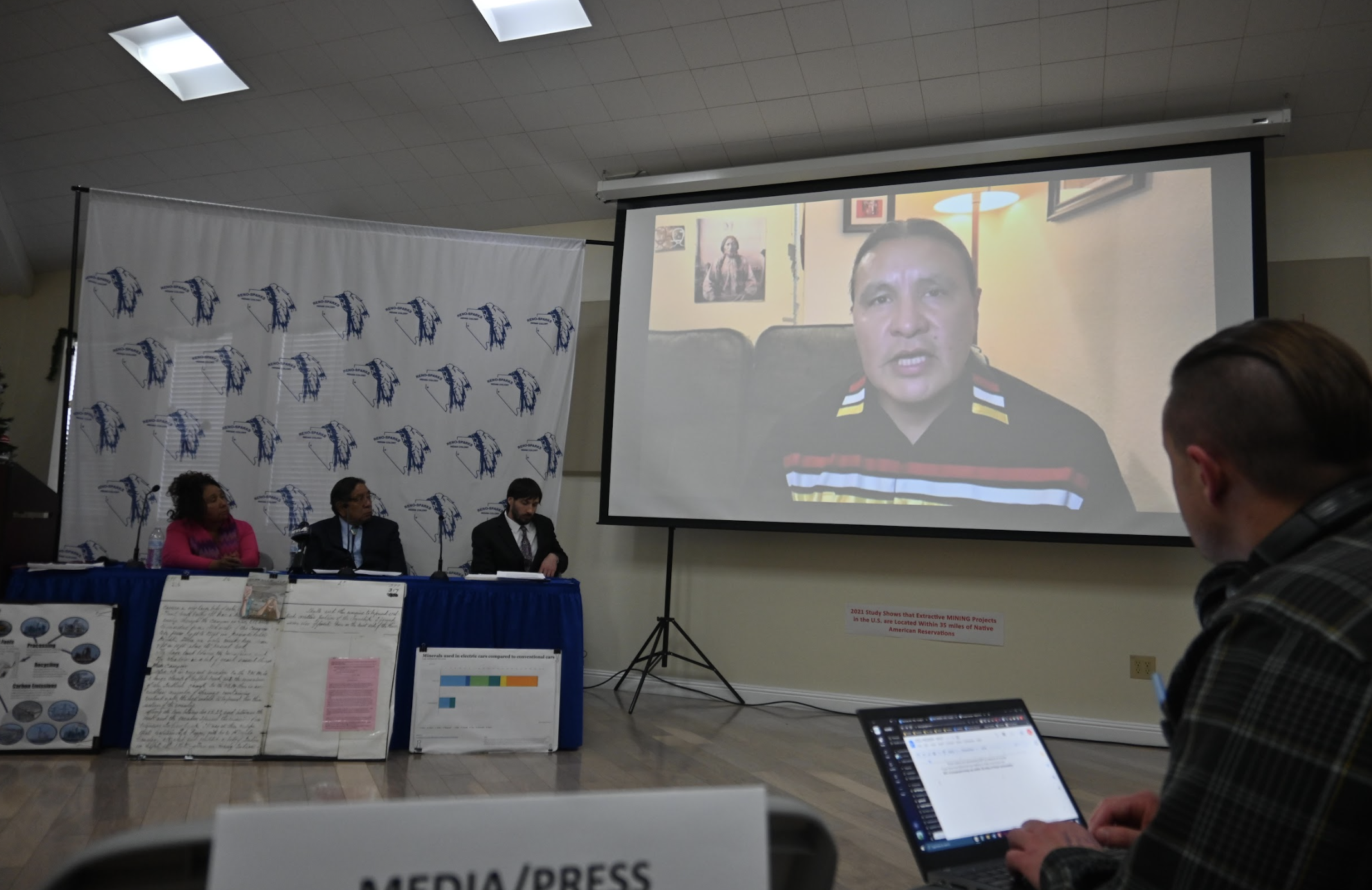A news conference about the Thacker Pass protest movement against lithium mining recently got media attention with Bethany Sam, communications director for the Reno-Sparks Indian Colony, one of the speakers, making the case for a new overall approach.
New Year’s means something different to everybody. Some relish the fresh start, others anguish over another year, gone.
Each holiday season brings a reheated plate of the same existential crisis: where does all the time go? For Indigenous tribes in northern Nevada, the new calendar year carries with it a lingering issue– sacred lands are being destroyed in order to create an open pit lithium mine.
If we really went back in time, we’d land in the Miocene Epoch. Earth may look quite strange. The world was getting warmer. Thick forests were transforming into grasslands. Bears, dogs, and giraffes all emerged as new species. The Sierra Nevada mountains sprung into the sky as tectonic plates rocked and rolled. It was a time before human hands and greed.
During this period of change, a supervolcano erupted, right in the middle of what’s now the northern Nevada/southeastern Oregon border. Magma spouted from the volcano’s mouth– a thousand times more magma than Mt. Saint Helens’ eruption in 1980.
With all the scorching liquid and rock dispersed, the volcano collapsed into itself. This created a feature called a caldera, a large bowl carved out of the landscape. This particular caldera was named McDermitt. McDermitt is set apart from other calderas (like Crater Lake) by a unique trait: it’s hypothesized to hold 20-40 metric tons of lithium. Which, if true, makes it the largest lithium deposit on Earth.
One of the slides shown during the December presentation denouncing “greenwashing.”
Millions of years after McDermitt was born and its minerals had settled firmly into the clay, the first humans made their way to the North American west. Over time, several tribes formed: the Numa/Numu (Northern Paiute), Washeshu (Washoe), Newe (Shoshone), and Nuwuvi (Southern Paiute) tribes, to name a few. Many native groups from all across the West moved and danced along the Nevadan land we inhabit today.
“Our ancestors didn't have fences, boundaries, and lines,” says Michon Eben, who serves as the historical preservation officer at the Reno-Sparks Indian Colony. “That's colonization…a European value.” Together, the tribes hunted, gathered medicinal plants, prayed, laughed.
Then, in the early morning darkness on September 12, 1865, a group of Paiute people were massacred as they slept. After an 1864 mandate instructing the US army to “kill and destroy,” the 1st Nevada Calvary ambushed a tribal camp and murdered dozens of Indigenous men, women, and children. The area is widely known today as Thacker Pass. Its original Paiute name is Peehee Mu’huh– “rotten moon.”
“You think about getting attacked early in the morning, in your own home, and you don't have weapons to defend yourself,” says Eben. “What do you do? You don't…stand there and take it. You run.” Both oral and written histories have documented the aftermath of the ambush. According to an article in the Owyhee Avalanche newspaper published two weeks later, infantrymen tracked and killed survivors “over several miles of ground, for three hours.”
If anyone returned to retrieve the bodies, “they were shot on sight. That's why we know this is an unmarked burial ground,” Eben recounted.
Michon Ebren, the tribal historic preservation officer for the Reno-Sparks Indian Colony pointed to detailed maps during her presentation as it was announced a three-year lawsuit aimed at blocking the lithium mine at Thacker Pass would be abandoned, with focus being placed on other strategies to protect the sacred land such as reinforced coalitions with advocacy groups.
However, this sacred land holds no “official” significance to the American government, and was therefore handed over to Lithium Americas with, seemingly, very little thought from the BLM. In fact, the “Record of Decision” which approved the project was released less than a year after the Environmental Impact Statement process. In that time, the Bureau of Land Management had sent letters to four of the tribes with ancestral ties to the land. No one had replied when the decision was released.
Just over 100 years after the slaughter of Paiute families, Chevron Minerals Inc. began to explore the geological makeup of the McDermitt caldera. They detected a bounty of lithium in the rocks of Thacker Pass. Chevron alerted the US Geological Survey, who went to work hunting for lithium and other minerals embedded throughout the land.
Around that same time, lithium ion batteries were emerging from the lab and making their debut in the commercial world. The first car to use a Li-ion battery was the 1998 Nissan Altra EV. Ten years later, Tesla Motors swooped in and capitalized on mass producing Li-ion battery powered vehicles, with the debut of its Roadster sports car.
Speakers were also teleconferenced in denouncing the massive lithium mine project during the December news conference.
As the global climate crisis escalates, EVs have become a beacon of hope for individuals and institutions alike. One of President Biden’s “Investing in America” goals is that half of all new vehicle sales are EVs by 2030. For some, “clean energy” clears the consciousness for a little while. Despite its recent recall of over two million vehicles, Tesla has become one of the most popular car manufacturers in the market, with production and sales growing massively since the Roadster. Social responsibility by way of luxury cars with 300 mile range is too good for some to pass on.
Until now, most of the lithium for Li-ion batteries (used not only for EVs, but also phones, laptops, electric scooters, and more) has been sourced from China. The only operational lithium mine in the US is located in Clayton Valley, Nevada. After adding Thacker Pass and its expected mineral quantities to that equation, many have started referring to Nevada as the “silicon valley of lithium,” and the hub of the “white gold rush.”
The Paiute name for Thacker Pass is Peehee Mu’huh meaning “rotten moon.”
The law that currently governs the mining of materials in the United States is over 150 years old, signed in 1872. That law deems “all valuable mineral deposits in land belonging to the United States to be free and open to exploration and purchase.” On June 4th, 2020, Donald Trump signed an executive order that allowed fast-tracked permitting on mining projects, indicating that the former process involved “unnecessary regulatory delays.”
One of those “unnecessary” delays would require in-depth consultation with local communities– the folks rocked most heavily by the social, economic, and environmental impacts of such projects. Instead, leaders of Indigenous groups were sent snail mail, which they did not reply to, meaning– there was no consultation. When the BLM approved the mining of Thacker Pass on January 15th 2021, some locals were hearing about the project for the first time.
Within the next month, two lawsuits were filed against the BLM. The National Congress of American Indians (NCAI), Reno-Sparks Indian Colony, People of Red Mountain, the Burns-Paiute tribe, Winnemucca Indian Colony, multiple environmental groups and one local rancher named Ed Bartell all worked to counter the BLM’s decision. The lawsuits were dismissed by judge Miranda Du on February 6th, 2023. Ten days later, another lawsuit was filed by three Native American tribes. This one saw the same fate.
“BLM…and Lithium (Americas), they will tell you that this is where the massacre occurred,” Eben says, pointing to a small area on the map, just east of the proposed mining project area. “We're saying no... this is where the massacre started.”
According to the aforementioned history, survivors of the initial attack ran west, towards the lithium, towards what would be turned into an open pit just a century and a half later. Those who were hunted and killed in Thacker Pass, unable to be retrieved by their loved ones, could very well have found their final resting place on the same land that is now being mined for car energy.
Lithium Americas, the company permitted by the BLM to mine Thacker Pass, started construction about a month after the last lawsuit was dismissed, in March of 2023. The company projects the extraction of about 40,000 tons of lithium a year for the first ten years, moving to potentially 80,000 tons a year in “phase 2.” Operations are expected to last 40 or more years.
In addition to grieving their ancestral burial sites and fearing for the livelihood of wild animal species in the area, local Indigenous peoples are wary of the long term impacts of a large lithium mine in their backyard. There is no real assurance that the massive amount of waste produced overtime will not wind up in their water, or in the air.
Mining also brings “man camps,” which have historically contributed to the abductions and murders of Indigenous girls and women. Not to mention that “tribes have never received a dime from mining,” according to the now retired colony chairman Arlan Melendez.
When reflecting on the wearisome legal battle fought by his community, against a seemingly invincible government giant, Melendez says: “We didn’t lose because we were wrong. We lost the lawsuit because the law favors mining, especially in our state.”
When a law prioritizes minerals over the well-being of a people group, it’s time to reconsider. According to the World Economic Forum, environmental racism is “a form of systemic racism whereby communities of color are disproportionately burdened with health hazards through policies and practices that force them to live in proximity to sources of toxic waste.” The article also mentions the specific exploitation of Indigenous communities due to weaker land laws.
Environmental racism usually occurs under the radar, disproportionately affecting communities. Folks living in Flint, Michigan, were drinking lead-filled water for eighteen months before they were widely heard. The environmental racism that is taking place at Thacker Pass is operating under the guise of so-called “green energy.”
2024 will bring something different for everybody. Some will buy floral printed planners and fill its pages with swirly resolutions, others might sob in public every day for the first few weeks. The years move fast, but for those of us still here, we can still get shit done. If not for ourselves, then for Thacker Pass and all the other sacred places that tend to disappear or get degraded with the passing of American time.





